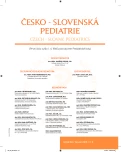Nutritional screening upon admission to hospital – NutriAction
Authors:
P. Frühauf 1; D. Barnetová; J. Bronský; F. Jimramovský; E. Karásková; R. Kotalová; P. Lokaj; J. Nevoral; O. Pozler; J. Sýkora; E. Šípková
Authors‘ workplace:
Klinika dětského a dorostového lékařství UK 1. LF a VFN, Prahapřednosta prof. MUDr. J. Zeman, DrSc.
Skupina NutriAction – při Pracovní skupině pro gastroenterologii a výživu České pediatrické společnosti ČLS JEP
1
Published in:
Čes-slov Pediat 2013; 68 (3): 157-160.
Category:
Original Papers
Overview
In the nutritional screening executed among 2988 children and adolescents at the age of 1 to 19 years upon admission to hospital to the Children Ward it has become obvious that almost 28% of admitted patients displayed medium risk of mal nutrition development ad 2% of the admitted patients were in a high risk. A higher risk was associated with a more frequent stay at the intensive care unit. Defined enteric nutrition given orally represented the most frequent nutritional intervention, followed by introduction of parenteral nutrition or administration of enteric nutrition by a probe. At the faculty hospitals there was more often the nutritional therapist or nutritional specialist who took care of the patients. Almost 16% of admitted patients and classified at high risk of malnutrition did not enjoy any nutritional intervention and received a common diet corresponding to their age. The introduction of nutritional screening represents the main step forward in the diagnostics of malnutrition. The detection of nutritional state disorder is the reason for nutritional intervention and further observation of the nutritional conditions of children admitted to the children wards.
Key words:
screening of nutritional state, nutritional intervention.
Sources
1. Hulst JM, Zwart H, Hop WC, Joosten KF. Dutch national survey to test the STRONGkids nutritional risk scree-ning tool in hospitalized children. Clin Nutrition 2010; 29: 106–111.
2. Merritt RJ, Suskind RM. Nutritional survey of hospitalized children. Am J Clin Nutr 1979; 32: 1320–1325.
3. Parsons HG, Francoeur TE, Howland P, et al. The nutritional status of hospitalized children. Am J Clin Nutr 1980; 33: 1140–1146.
4. Cooper A, Jakobowski D, Spiker J, et al. Nutritional assessment. An integral part of the preoperative pediatric surgical evaluation. J Pediatr Surg 1981; 16: 554–560.
5. Moy RJ, Smallman S, Booth IW. Malnutrition in a UK children’s hospital. J Hum Nutr Diet 1990; 3: 93–100.
6. Smith DE, Stevens MCG, Booth IW. Malnutrition at diagnosis ofmalignancy in childhood: common but mostly missed. Eur J Pediatr 1991; 150: 318–322.
7. Hendriks KM, Duggan C, Gallagher L, et al. Malnutrition in hospitalized pediatric patients. Arch Pediatr Adolesc Med 1995; 149: 1118–1122.
8. Hendrikse WH, Reilly J, Weaver LT. Malnutrition in a UK children’s hospital. Clin Nutr 1997; 16: 13–18.
9. Dogan Y, Erkan T, Yalvac S, Altay S, Cokugras FC, et al. Nutritional status of patients hospitalized in pediatric clinic. Turk J Gastroenterol 2005; 16: 212–216.
10. Hendricks KM, Duggan C, Gallagher L, Carlin AC, Richardson DS, et al. Malnutrition in hospitalized pediatric patients. Current prevalence. Arch Pediatr Adolesc Med 1995; 149: 1118–1122.
11. Marteletti O, Caldari D, Guimber D, Mention K, Michaud L, Gottrand F. Malnutrition screening in hospitalized children: influence of the hospitalunit on its management. Arch Pediatr 2005; 12: 1226–1231.
12. Moy R, Smallman S, Booth I. Malnutrition in a UK children’s hospital. J Hum Nutr Diet 1990; 3: 93–100.
13. Pawellek I, Dokoupil K, Koletzko B. Prevalence of malnutrition in paediatric hospital patients. Clin Nutr 2008; 27: 72–76.
14. Tláskal P, Michková E, Baláčková J, Dlask K, Krásničanová H, Kinclová E, Kulichová J. Stav výživy hospitalizovaných dětí. Čes-slov Pediat 2000; 55: 292–295.
15. Joosten KF, Zwart H, Hop WC, Hulst JM. National malnutrition screening days in hospitalized children in the Netherlands. Arch Dis Child 2010; 95: 141–145.
Labels
Neonatology Paediatrics General practitioner for children and adolescentsArticle was published in
Czech-Slovak Pediatrics

2013 Issue 3
Most read in this issue
- Hirschsprung´s disease and its genetic cause
- Nutritional screening upon admission to hospital – NutriAction
- Congenital surfactant deficiency due to ABCA3 mutations leading to fatal respiratory failure in a newborn
-
Incidence of idiopathic enteric inflammations in children and adolescents in the Plzeň (Pilsen) Region in 2001–2011.
A Prospective study
